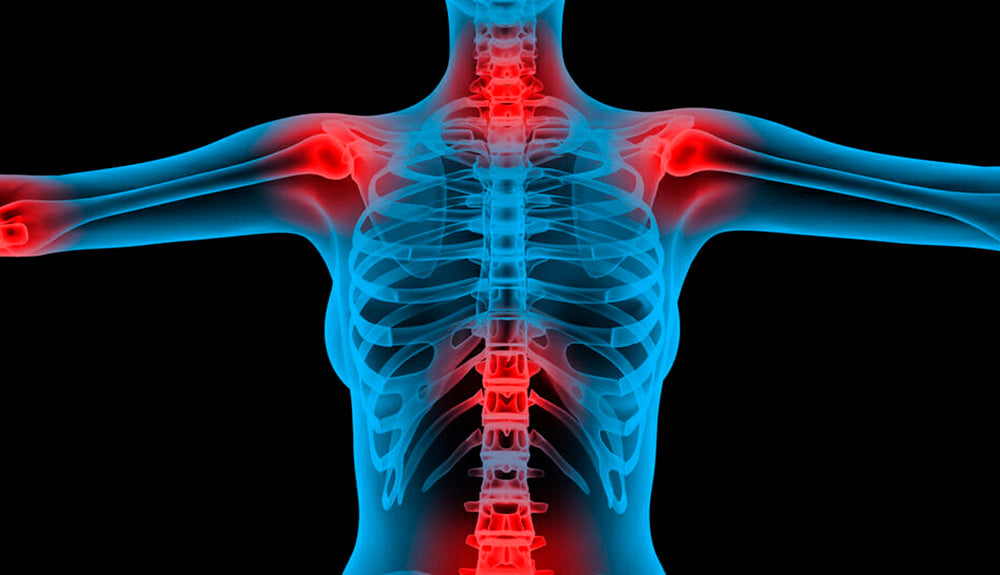The aging process is accompanied by a chronic, smoldering background of inflammation that researchers call “inflammaging”. This backdrop of low-grade inflammation contributes significantly to mortality risk in the elderly and has a number of sources.
Today, we are going to take a look at inflammaging and the various known sources that promote this age-related inflammatory condition.
Inflammaging precedes many age-related diseases
The chronic inflammation that accompanies the aging process is believed to be a significant risk factor for a myriad of age-related diseases, such as atherosclerosis, arthritis, hypertension, and cancer [1-3].
The burden of unhealthy lifestyles is rising globally and, with it, an increase in age-related diseases. While lifestyle changes may help to reduce the risk of age-related diseases, this is by no means a guarantee.
The immune system relies on acute inflammation during the immune response to fight invading pathogens and to facilitate wound healing. This triggers cell turnover and tissue repair and is, in general, a desirable reason for inflammation. However, in direct contrast to this, inflammaging produces a chronic, low-grade, persistent background of inflammation that leads to poor tissue repair and degeneration [4].
This chronic inflammation also contributes to the development of age-related diseases and is instrumental in driving the aging process in general [5]. In older people, the tissues have high levels of inflammatory cytokines, such as IL-6, IL-1β, TGF-b, and TNF-α, which are known to interfere with anabolic signaling, including insulin and erythropoietin signaling, thus contributing to the development of sarcopenia. This is part of the aging hallmark of deregulated nutrient sensing [6].
This inflammation also plays a key role in reducing the level of NAD+ and sirtuin activity by increasing CD38 in tissue, which is linked to the development of sarcopenia and other age-related diseases [7-9].
Senescent cells
Cells are driven into a senescent, non-dividing state by a number of factors, including telomere shortening, DNA damage, genotoxic stress, and inflammatory cytokines. These all result in the activation of the p53 tumor suppressor and/or the cyclin-dependent kinase inhibitor p16 [10]. The immune system clears away these damaged cells during normal operation; however, as we age, the clearing away of these cells declines, and increasing numbers linger in tissues and secrete an inflammatory cocktail of cytokines known as the senescence-associated secretory phenotype, or SASP.
Based on the evidence to date, it seems likely that senescent cells are the main source of inflammaging during the aging process [11-12]. An increasing body of evidence suggests that the therapeutic removal of these problem senescent cells could delay or even prevent various age-related diseases, including atherosclerosis and osteoarthritis [13-17].
Microbial burden
The oral and gut mucosa barriers that protect against bacterial invasion begin to both decline in effectiveness and break down as we age. Periodontal disease has been shown to shown to contribute to inflammaging by generating chronic, low-grade inflammation [18]. In the gut, the microbiota shows an increasing decline of diversity with age [19-20].
For example, one study showed that beneficial bacteria like Bifidobacterium spp., and F. prausnitzii, which play an anti-inflammatory role in the gut microbiome, decline with age, allowing inflammation to increase [21]. The level of Bifidobacterium directly influences the levels of inflammatory cytokines present in the bloodstream, with less Bifidobacterium corresponding to more inflammation. The opposite is true of harmful bacteria, such as Streptococcus spp., Staphylococcus spp., Enterococcus spp. and Enterobacter spp, which increase with age and promote inflammation and disease.
The role of microbial burden and the microbiome is becoming increasingly clear, and studies like one performed in China last year show the connection [22]. This large-scale study found that the healthiest aged people had gut microbiomes similar to much younger people; in other words, they maintained diversity and thus lower levels of inflammation.
Immunosenescence
Immunosenescence, the age-related decline of the immune system, is typified by inappropriate immune responses that generate persistent levels of inflammation as a result [23]. Immunosenescence increases our vulnerability to infections, autoimmune reactions, and cancer while decreasing our response to vaccinations and disrupting wound healing [24-25].
While not fully understood, chronic inflammatory disease also appears to accelerate immunosenescence via affecting both the numbers and function of immune cells. Immunosenescence may also be accelerated and aggravated by persistent infections, such as CMV, HIV, and Epstein–Barr virus, linking it to microbial burden.
Finally, because the immune system is responsible for removing senescent cells, its decline results in a loss of this ability, thus creating a downward spiral of increasing inflammation.
Cell Debris
Cell debris caused by inappropriate cell destruction and clearance during the aging process can trigger the innate immune system, which sets the scene for persistent inflammation. Cell debris (damage-associated molecular patterns, i.e., damaged organelles, cells, and macromolecules) accumulate with age as a consequence of both increased production and impaired elimination.
Of particular interest in recent years has been mitochondria-derived damage-associated molecular patterns (DAMPs), which are released by aged and damaged mitochondria. Mitochondrial DAMPs have been the focus of intense research recently due to their likely involvement with inflammaging and age-related diseases [26]. Due to their bacterial ancestry, the mitochondrial DAMPs increase inflammatory responses due to their interaction with receptors in a manner similar to those caused by regular pathogens.
Cell debris have recently been shown to disrupt tissue repair such as in nerve tissue where the improper clearance of debris by neutrophils impairs tissue regeneration [27].
Conclusion
These are just some of the known ways in which inflammation sources contribute to the smoldering background that is inflammaging. There is considerable evidence suggesting that many age-related diseases, such as cancer, heart disease, and Alzheimer’s, are linked to inflammaging.
Finding ways to manage and reduce inflammation from these and other sources therefore holds potential as a therapeutic approach to treating and preventing age-related diseases. Senolytic therapies that selectively destroy senescent cells to reduce inflammation are one example of how we might manage inflammaging.
Literature
[1] Freund A, Orjalo AV, Desprez PY, Campisi J. Inflammatory networks during cellular senescence: causes and consequences. Trends Mol Med (2010) 16(5):238–46. doi: 10.1016/j.molmed.2010.03.003
[2] Childs, B. G., Gluscevic, M., Baker, D. J., Laberge, R. M., Marquess, D., Dananberg, J., & van Deursen, J. M. (2017). Senescent cells: an emerging target for diseases of ageing. Nature Reviews Drug Discovery, 16(10), 718.
[3] He, S., & Sharpless, N. E. (2017). Senescence in health and disease. Cell, 169(6), 1000-1011.
[4] Straub, R. H., & Schradin, C. (2016). Chronic inflammatory systemic diseases: An evolutionary trade-off between acutely beneficial but chronically harmful programs. Evolution, medicine, and public health, 2016(1), 37-51.
[5] Franceschi, C., & Campisi, J. (2014). Chronic inflammation (inflammaging) and its potential contribution to age-associated diseases. Journals of Gerontology Series A: Biomedical Sciences and Medical Sciences, 69(Suppl_1), S4-S9.
[6] Beyer, I., Mets, T., & Bautmans, I. (2012). Chronic low-grade inflammation and age-related sarcopenia. Current Opinion in Clinical Nutrition & Metabolic Care, 15(1), 12-22.
[7] Sinclair D. Bonkowski, M. Impairment of an Endothelial NAD+-H2S Signaling Network Is a Reversible Cause of Vascular Aging (2018) doi.org/10.1016/j.cell.2018.02.008
[8] Camacho-Pereira, J., Tarragó, M. G., Chini, C. C., Nin, V., Escande, C., Warner, G. M., … & Chini, E. N. (2016). CD38 dictates age-related NAD decline and mitochondrial dysfunction through an SIRT3-dependent mechanism. Cell metabolism, 23(6), 1127-1139.
[9] Schultz, M. B., & Sinclair, D. A. (2016). Why NAD+ declines during aging: It’s destroyed. Cell metabolism, 23(6), 965-966.
[10] de Magalhães, J. P., & Passos, J. F. (2017). Stress, cell senescence and organismal ageing. Mechanisms of ageing and development.
[11] Sanada, F., Taniyama, Y., Azuma, J., Iekushi, K., Dosaka, N., Yokoi, T., … & Morishita, R. (2009). Hepatocyte Growth Factor, but not Vascular Endothelial Growth Factor, Attenuates Angiotensin II–Induced Endothelial Progenitor Cell Senescence. Hypertension, 53(1), 77-82.
[12] Tchkonia, T., Zhu, Y., Van Deursen, J., Campisi, J., & Kirkland, J. L. (2013). Cellular senescence and the senescent secretory phenotype: therapeutic opportunities. The Journal of clinical investigation, 123(3), 966-972.
[13] Childs, B. G., Baker, D. J., Wijshake, T., Conover, C. A., Campisi, J., & Van Deursen, J. M. (2016). Senescent intimal foam cells are deleterious at all stages of atherosclerosis. Science, 354(6311), 472-477.
[14] Jeon, O. H., Kim, C., Laberge, R. M., Demaria, M., Rathod, S., Vasserot, A. P., … & Baker, D. J. (2017). Local clearance of senescent cells attenuates the development of post-traumatic osteoarthritis and creates a pro-regenerative environment. Nature medicine, 23(6), 775.
[15] Baker, D. J., Wijshake, T., Tchkonia, T., LeBrasseur, N. K., Childs, B. G., Van De Sluis, B., … & Van Deursen, J. M. (2011). Clearance of p16 Ink4a-positive senescent cells delays ageing-associated disorders. Nature, 479(7372), 232.
[16] Zhu, Y., Tchkonia, T., Pirtskhalava, T., Gower, A. C., Ding, H., Giorgadze, N., … & O’hara, S. P. (2015). The Achilles’ heel of senescent cells: from transcriptome to senolytic drugs. Aging cell, 14(4), 644-658.
[17] Roos, C. M., Zhang, B., Palmer, A. K., Ogrodnik, M. B., Pirtskhalava, T., Thalji, N. M., … & Zhu, Y. (2016). Chronic senolytic treatment alleviates established vasomotor dysfunction in aged or atherosclerotic mice. Aging Cell, 15(5), 973-977.
[18] Franceschi, C., Garagnani, P., Vitale, G., Capri, M., & Salvioli, S. (2017). Inflammaging and ‘Garb-aging’. Trends in Endocrinology & Metabolism, 28(3), 199-212.
[19] Kinross, J., & Nicholson, J. K. (2012). Gut microbiota: dietary and social modulation of gut microbiota in the elderly. Nature Reviews Gastroenterology and Hepatology, 9(10), 563.
[20] Claesson, M. J., Cusack, S., O’Sullivan, O., Greene-Diniz, R., de Weerd, H., Flannery, E., … & Stanton, C. (2011). Composition, variability, and temporal stability of the intestinal microbiota of the elderly. Proceedings of the National Academy of Sciences, 108(Supplement 1), 4586-4591.
[21] Toward, R., Montandon, S., Walton, G., & Gibson, G. R. (2012). Effect of prebiotics on the human gut microbiota of elderly persons. Gut microbes, 3(1), 57-60.
[22] Bian, G., Gloor, G. B., Gong, A., Jia, C., Zhang, W., Hu, J., … & Burton, J. P. (2017). The Gut Microbiota of Healthy Aged Chinese Is Similar to That of the Healthy Young. mSphere, 2(5), e00327-17.
[23] Shaw, A. C., Goldstein, D. R., & Montgomery, R. R. (2013). Age-dependent dysregulation of innate immunity. Nature Reviews Immunology, 13(12), 875.
[24] Aw, D., Silva, A. B., & Palmer, D. B. (2007). Immunosenescence: emerging challenges for an ageing population. Immunology, 120(4), 435-446.
[25] Gruver, A. L., Hudson, L. L., & Sempowski, G. D. (2007). Immunosenescence of ageing. The Journal of pathology, 211(2), 144-156.
[26] Zhang, Q., Raoof, M., Chen, Y., Sumi, Y., Sursal, T., Junger, W., … & Hauser, C. J. (2010). Circulating mitochondrial DAMPs cause inflammatory responses to injury. Nature, 464(7285), 104.
[27] Lindborg, J. A., Mack, M., & Zigmond, R. E. (2017). Neutrophils are critical for myelin removal in a peripheral nerve injury model of Wallerian degeneration. Journal of Neuroscience, 2085-17.
This article was first published by Steve Hill for Life Extension Advocacy Foundation.





